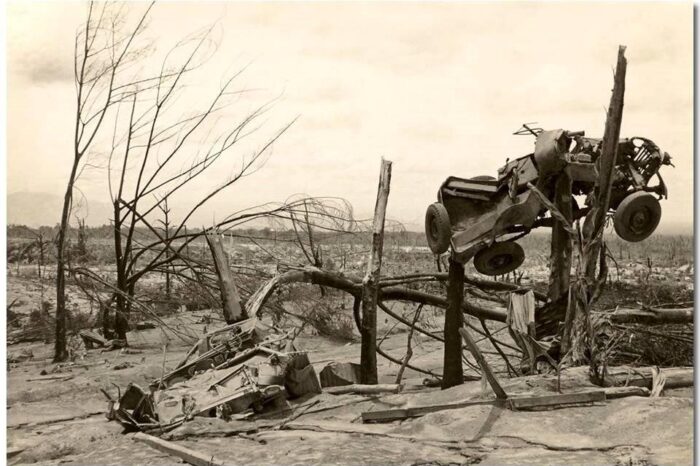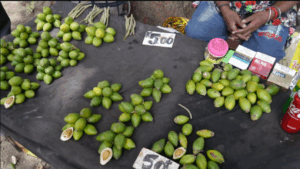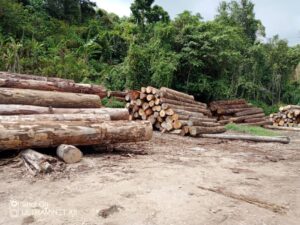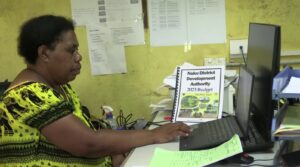Award winning PNG filmmaker tells of her childhood during the Bougainville Crisis

In 2015, a film collection called Pawa Meri documenting the lives of exceptional Papua New Guineans women working in their communities gained international attention when it won three awards at the International Film festival for Peace, Inspiration and Equality.
The festival, held in Indonesia, brought together film makers from all over the world.
Two awards – the 2015 International Award of Excellence and the Award of Excellence were given for the films.
A third award was given to the character in the film, Bougainvillean Catholic nun, Sister Lorraine Garasu, whose years of work in peace building has earned her numerous recognition.
The Papua New Guinean entries were sent in by film maker, Llane Munau, who didn’t attend the festival.
Llane is one of the very few filmmakers in the country. She is also one of the few who have gone on to win international awards for her work.
“I think the influence came from my dad. He would encourage us to tell stories. He would take me to the cinema and to watch plays.”
Llane was born in Arawa, South of Bougainville in 1979. Her dad, Francis, was a mechanical engineer. Her mum, Trish, also worked as a stenographer for the Bougainville copper mine. For a child, the pre-crisis era was a wonderful time. With a mine that generated substantial amounts of revenue and jobs for the country, the capital of the province, was a model economic hub teeming with life and social activity.
By 1989, the Bougainville Crisis began and the Panguna Mine was shut down.

Instead of leaving the island, Francis and Trish chose to stay. But they both had to work out a way to protect their children from the bloodshed that was already happening around them.
Llane was 10 and about to start fourth grade when her parents told her and two other siblings that they had to leave Arawa. Llane says she understood very little about the civil war that had begun.
“I knew that most of my uncles had been killed and I knew some of the things that were happening.
“But my parents protected us so well. I can remember my dad telling us that we were going on a long holiday in the bush. We were excited and really looking forward to it.
The family spent the next five years from 1989 to 1994 living in the jungles of South Bougainville. With no schools or government services open at the time, Llane became one of the many crisis era kids who didn’t attend school for half a decade.
But Bougainvillean ingenuity and creativity didn’t die during the crisis. Llane’s mechanical engineer dad made sure his children got an education in the jungles.
“When we left, we took encyclopedias and bibles. We learnt everything that was in the encyclopedias. Our dad would quiz us about stories in the bible.”
Despite the crisis, Francis and Trish, created a structured routine that included school from 8am to 12pm. Then, chores and reading for the rest of the day. Llane and her siblings learned about the Royal Family in England, plants and animals.
“We also took old Women’s day magazines and we used to read them and do crosswords.”
After five years living in the bush, time came for them to leave. Outside of their protected circle, the children knew very little about the fighting, the care centers and the arrival of the PNG Defence Force.
“Looking back, my dad also prepared us for the day we were going to meet the army. He told us the good things about the army…about the planes, ships and soldiers.
“About care centers, he also told us we would be going to camps where all our relatives were living”
“Then we went and surrendered to the PNGDF at Nagovis. They were very kind to us.”
To the surprise of soldiers and many who were living near Arawa, Llane and her siblings appeared to have received a very good education even after not having seen the inside of a classroom for five years.
“When we came out of the bush, I was 15. They were surprised that we could speak good English.
“We helped the PNGDF translate for the older people who were living in the care centers.”
After missing out on five years of school, Llane skipped one grade and went into grade five in the middle of the school year in 1994.
As a young adult, at Divine Word University, she was eventually confronted with the reality of the Bougainville crisis. Poring through reading material available at the time, she saw the difficulties that her people went through during the 10 year conflict.
“I didn’t know until much later, that my dad was nearly killed. He never talked about it.
“I was reading about the stories of men and women who suffered during the crisis and I questioned myself.
“Were we in the same crisis? I had not learned about it?”
With the help of her lecturers at DWU, Llane was trained by film makers, Chris Owen and Pengau Nengo who produced early Papua New Guinean films in the 70s and 80s. This gave her the opportunity to grow her childhood passion of story telling.
“I remember telling my lecturers that if I was not going to learn about visual story telling, I wouldn’t be happy just studying journalism. I wanted to tell stories using pictures.”
In 2016, at the Anuu Ru Aboro International Film Festival in New Caledonia, her film Wosera Justice, won the Best Short Documentary Film Award in the Pacific. The film tells the story of Anna Kimbange, a Sepik woman in a remote area of Wosera, who works to resolve conflict and bring peace in her community.
“I am telling positive stories about Papua New Guinea. While there are instances of violence, Anna was resolving issues but doing it their way.
“Papua New Guinea is a really beautiful country. I live in the highlands and people talk about tribal fights… but it’s not all about tribal fights here.”
As a filmmaker, Llane is looking to a future where film makers are supported by government funding so that the industry, which already had a huge PNG and Pacific market, is encouraged to grow.
“This industry is a sleeping giant. Look at Nigeria’s Nollywood and India’s Bollywood. They influence change in their own country in a big way. They influence the fashion and the mindset.
“We can do that in Papua New Guinea!”






